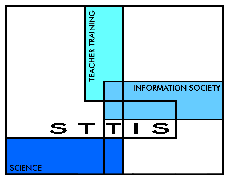
Science Teacher Training
in an Information Society
 Teaching about energy
Teaching about energy

 |
Science Teacher Training
in an Information Society |
 |
Workshop 1
|
Aims
BackgroundPupils have little difficulty in believing that insulation will help to keep hot things hot. However, they may find it more difficult to see that it can help to keep cold things cold. Particularly puzzling may be that it does not affect something which is at room temperature. These practical activities explore these ideas.The practical activity is followed by an activity in which pupils match situations involving insulation with abstract pictures of energy flow. It could be done as a poster activity, with each group writing reasons for their matches on the poster. They should cut up the sheets showing the abstract pictures and lay them out on the poster in the arrangement shown below, leaving spaces to match the situations against them. Having made their choices and written their reasons, the posters can form the basis for a class discussion. Also included here are some examples of pupil discussion related to the activity on insulation, in order to give an idea of the range of understanding that might be expected. What to do1. Read page 3 which describes the practical activity, and make predictions of the temperatures as explained on the sheet. If you are doing the practical activity with pupils, then each group needs the following apparatus:Beaker, thermometer, boiling tube, insulated boiling tube (wrap cotton wool around the tube, then a plastic bag and seal with rubber bands), stop clock, access to water at 800C, 200C and 50C. 2. Typical values for each of the three pairs of tubes are 600C and 500C, 200C and 200C, 100C and 150C. Now try the questions on page 4. These are intended to encourage pupils to interpret these results by thinking about the direction and relative sizes of the energy flows due to temperature differences. The key idea here is that insulation is a barrier to energy flow. If you are doing this as a pupil activity, it may be useful to make this sheet up as an OHT for class discussion before they attempt the questions themselves. 3. Page 5, page 6 and page 7 include an activity in which situations are matched against abstract pictures. This is to enable pupils to apply the ideas they have learnt in the practical activity in a range of everyday situations. Cut out each of the situations and the abstract pictures as described in the instructions, and match the situations to the abstract pictures. It is better to cut out the pictures rather than to make the matches directly from the sheets, since this encourages more discussion and it is easier to see the patterns that emerge. 4. When you have completed the making the matches, then check your answers on page 2. If you have matched more than one situation against one abstract picture, then think about what is similar between the two situations. Making abstractions and generalisations about what appear to be different kinds of situation is of fundamental importance in thermodynamic thinking. 5. On page 8, there
are some examples of pupils discussing the activity using abstract pictures
of insulation. Read what they say. How well do you think they understand
the basic ideas about temperature differences, energy flows and insulation
as a barrier. How well do they differentiate between concepts such as energy,
heat and temperature? Can you identify any alternative ideas that they
hold?
|
| <<= Previous page | Introduction to Teachers' Workshop 1 | Next page =>> |